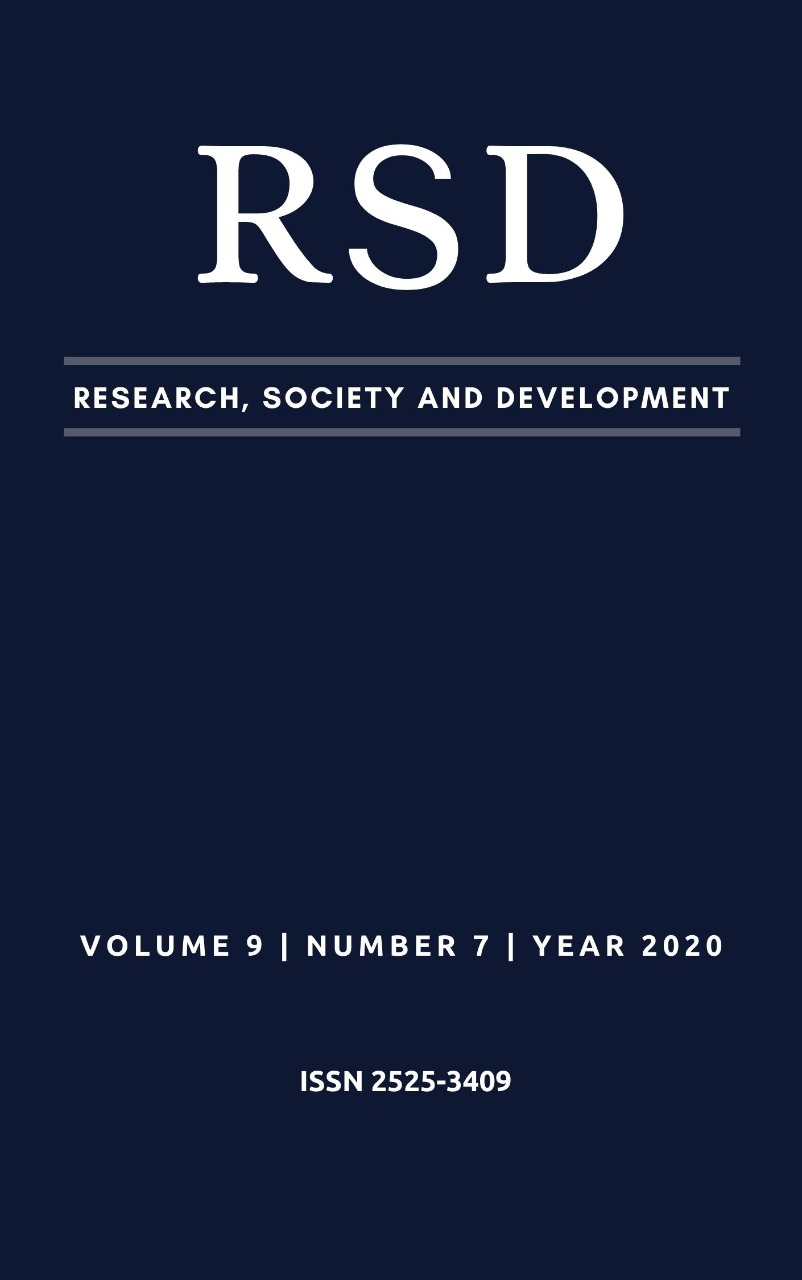Evaluacíon del conocimento de los veterinarios que trabajan en el municipio de Mineiros/GO sobre la Leishmaniasis Visceral Canina
DOI:
https://doi.org/10.33448/rsd-v9i7.4495Palabras clave:
Grupos profesionales, Comprensión, Leishmania, Medicina Veterinaria.Resumen
La leishmaniasis visceral canina (LVC) es una zoonosis crónica, cuyo agente etiológico es la Leishmania chagasi transmitida por insectos del género Lutzomyia. Es uma enfermidad sistémica que afecta a los órganos linfoides (medula ósea, bazo y ganglios linfáticos). La propagación de la enfermidad está estrechamente relacionada con las formas de abordarla a través de los profesionales de la salud. Sin embargo, es muy importante que estos profesionales tengan conocimiento y dominio sobre la enfermidad. Entonces, el objetivo de este trabalho fue evaluar el conocimiento de los medicos veterinarios que trabajan em la ciudad de Mineiros/GO sobre la LVC e lo que se ha hecho para lidiar com casos confirmados de la enfermidad. Se realizaron 10 entrevistas a través cuestionarios semi estructurados que contenían 12 preguntas. Todos los entrevistados demonstraron conocimiento sobre la LVC, y relacionan la forma de transmisión a traves del “mosquito palha”. Cuando se le preguntaran sobre animales que poderían se infectar, 60% respondieron perros y gatos, y 40% solo perros. Solo uno encuestado respondió correctamente sobre los síntomas de los animales afectados. Se observo um alto nível de conocimiento em relación com el diagnostico y el tratamiento. Cuanto a los métodos preventivos, 33,3% se relaciono com el uso de colar repelente, 22.22% com higiene do local, 27,8% com vacunación de los animales, 5,55% com repelentes, 5,55% com evitar las picaduras del insecto y por fin, 5,55% incluyó la eutanásia del perro infectado. Sin embargo, 90% de los profesionales recomiendan la vacunación. Se concluye que los medicos veterinarios que trabajan en Mineiros/GO tienen alto conocimiento sobre la enfermidad, principalmente com respecto al modo transmisión, diagnósticos y medidas preventivas. Pero se observa una falta de conocimiento sobre los sintomas presentados por los perros infectados.
Referencias
Alvarenga, D. G.; Escalda, P. M. F.; Costa, A. S. V.; & Monreal, M. T. F. D. (2010). Leishmaniose visceral: estudo retrospectivo de fatores associados à letalidade. Revista da Sociedade Brasileira de Medicina Tropical, 2(43), 194-197.
Brandão, T. G. E. & Montanha, F. P. (2011). Leishmaniose Visceral – Revisão De Literatura. Revista Científica Eletrônica de Medicina Veterinária, 2(16), 1-6.
Brasil. (2014). Manual de vigilância e controle da leishmaniose visceral. Brasília: Ministério da Saúde.
Brasil. (2017). Leishmaniose Visceral em Goiás – Aspectos epidemiológicos. Boletim epidemiológico, 18(3).
Bondan, E. F. & Camargo, T. C. (2014). Conhecimento sobre leishmaniose visceral canina na população do município de Cotia (SP), Brasil, e participação dos clínicos veterinários locais na propagação de medidas preventivas. Revista Brasileira de Ciência Veterinária, 22(1),28-33.
Freitas, B. R.; Rabelo, E. L.; Borges K. I. N.; Souza, K. A.; & Fransosi, J. M. (2014). Estudo epidemiológico dos casos de leishmaniose em humanos e cães no município de Mineiros Goiás. Encontro de Iniciação Científica Sustentabilidade, Economia Verde e Erradicação da Pobreza. 1-6.
Gontijo, C. M. F. & Melo, M. N. (2004). Leishmaniose Visceral no Brasil: quadro atual, desafios e perspectivas. Revista Brasileira Epidemiológica, 7(3), 200.
Guimarães, E. L. A. M. (2013). Conhecimento sobre leishmaniose visceral e prática das medidas de prevenção e controle por proprietários de cães em Belo Horizonte, 2010/2011. Dissertação (Mestre em Ciência Animal). Universidade Federal de Minas Gerais Escola de Veterinária, Belo Horizonte MG.
Marcondes, M. & Rossi, C. N. (2013). Leishmaniose visceral no Brasil. Brazilian Journal Veterinary Research and Animal Science, 50(5), 341-352.
Massia, L. I. (2017). Leishmaniose visceral: avaliação do conhecimento dos agentes de saúde pública em Uruguaiana (RS). Dissertação (Pós-graduação Stricto Sensu em Ciência Animal) - Universidade Federal do Pampa. Uruguaiana.
Meirelles, B. R. B.; Sousa, D. B.; Paula, E. M. N.; Cruz, C. A.; Moraes, F. C.; Nascimento, K. A.; Araújo, D. P.; Azevedo, D. A.; & Costa Filho, R. I. (2015). Percepção dos professores da rede pública municipal de ensino do município de Jataí–Go sobre a prevenção da leishmaniose. Anais II Simpósio Sul-Mineiro de Doenças Negligenciadas. Minas Gerais, 47.
Mutzemberg, E. R.; Almeida, A. B. P. F.; & Sousa, V. R. F. (2012). Como os médicos-veterinários de Cuiabá/MT encaram a leishmaniose visceral canina? Revista Eletrônica De Extensão. 9(13), 32-41.
Pereira, A. S.; Shitsuka, D. M.; Parreira, F. J.; Shitsuka, R. (2018). Metodologia da pesquisa científica. [e-book]. Santa Maria. Ed. UAB/NTE/UFSM. Acesso em: 14 maio 2020. Disponível em: https://repositorio.ufsm.br/bitstream/handle/1/15824/Lic_Computacao_ Metodologia-Pesquisa-Cientifica.pdf?sequence=1.
Paula, E. M. N.; Paula, C. R.; Presotto, L. G.; Bartoli, D. S.; & Meirelles. B. R. B. (2015). Pesquisa entomológica de flebotomínios no município de Jataí-Go após diagnóstico do primeiro caso alóctone de leishmaniose visceral canina. Anais do II Simpósio Sul-Mineiro de Doenças Negligenciadas. Minas Gerais, 27.
Pita, P. D.; Cardoso, M. A.; Alves, C. R.; Brasil, R. P.; & Brito, C. (2008). Detection of natural infection in Lutzomyia cruzi and Lutzomyia forattinii Diptera: Psychodidae. Acta tropica, 107(1) 66-69.
Schimming, B. C., & Silva, J. R. C. P. (2012). Leishmaniose Visceral Canina: Revisão de literatura. Revista Científica Eletrônica de Medicina Veterinária, 19(1) 1-17.
Descargas
Publicado
Número
Sección
Licencia
Los autores que publican en esta revista concuerdan con los siguientes términos:
1) Los autores mantienen los derechos de autor y conceden a la revista el derecho de primera publicación, con el trabajo simultáneamente licenciado bajo la Licencia Creative Commons Attribution que permite el compartir el trabajo con reconocimiento de la autoría y publicación inicial en esta revista.
2) Los autores tienen autorización para asumir contratos adicionales por separado, para distribución no exclusiva de la versión del trabajo publicada en esta revista (por ejemplo, publicar en repositorio institucional o como capítulo de libro), con reconocimiento de autoría y publicación inicial en esta revista.
3) Los autores tienen permiso y son estimulados a publicar y distribuir su trabajo en línea (por ejemplo, en repositorios institucionales o en su página personal) a cualquier punto antes o durante el proceso editorial, ya que esto puede generar cambios productivos, así como aumentar el impacto y la cita del trabajo publicado.


